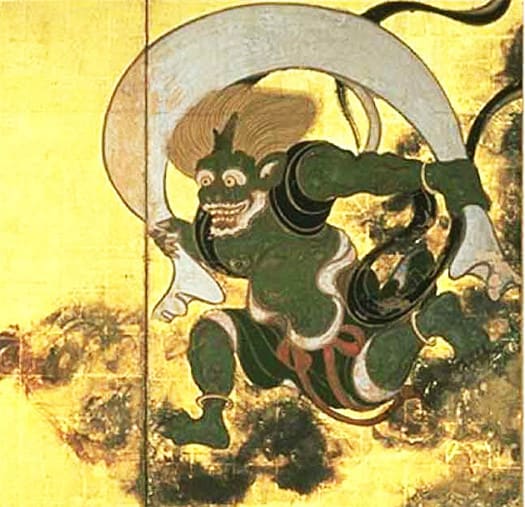

加齢してきて住宅雑誌ビジネス的な立場からだんだん離れ自分自身で「表現」するということに関心が高まってきています。というか自分の「したかったことーPart2」に関心領域が向かってきている。住宅についてはこれまでのメディアの立場から、むしろ取材者・表現者の立場に戻ってきていて、そういうスタンスでの掘り下げにこころが向かってきています。その方向性の表現についてはもう少し時間が経過したら発表することができると思います。
で、毎日書き続けているこのブログでは、それともまた少し違う領域での「掘り下げ」をしたいと思っています。前述の住宅テーマ表現についてきちんと発表可能になったら、また環境に違いが出てくるでしょうが、いまはそうした「過渡期」。
で、ブログネタとしては「絵画」の領域をしばらくは考えて行きたいと思っています。
これは数年ぶりに訪れて自分のなかの「数寄」をもう一回覚醒させられた後藤純男美術館での作品との対話復活が大きい要因。日本画というのは日本人の通底的な「花鳥風月」という精神性をきわめるような表現領域だと勝手に考えているのですが、そういう作家群のなかで後藤純男さんは、その創作拠点を上富良野に定めるほどに北海道の四季、自然に惚れ込まれた。
北海道での暮らしというのは伝統的な日本の「花鳥風月」がより過酷な自然環境に出会った、という意味合いが非常に強いと思っています。温帯の人間社会がはじめて本格的「寒冷地」に遭遇した、みたいな。北海道人は江戸期までの日本人的自然観からは大きくビッグバンした自然環境の中で否応なく暮らすことになったワケで、そういう「拡張された花鳥風月」への表現を、こころの底で大きく期待していたのではないかと思っている。
住宅というのは明治以降、北海道が国土参入することで「高断熱高気密」という技術的・基本的な領域での本質的価値転換があった。そのことによる日本人の「生活感の進化・変化」領域も非常に価値が大きいけれど、一方で精神性を表現する絵画芸術の領域でも、上述のような価値感進化を熱望する部分があったのではないかと思っている次第。
前置きがずいぶん長くなって、本題の絵柄のことにたどりつきません(泣)。過酷な「寒冷」ともまた違った自然の猛威として「台風」が周期的にやってくる日本列島で、ひとびとの精神性表現として受け継がれてきた「風神雷神」表現がわたしは大好きで、とくに俵屋宗達に強く惹かれてきた。それに対して最近、同じ日本の画家ながら、はるかに時代を遡る雪舟さんの表現に出会ったのです。
大好きな俵屋宗達に対して、雪舟はどのように表現だったのか。金屏風絵と墨絵という表現スタイルの違いが大きいのですが、非常に強く興味を掻き立てられたのであります。
・・・ちょっと長くなりすぎなので明日以降に続きます。
English version⬇
Sesshu and Sotatsu Tawaraya - The Expression of the “Wind God
The settlement of the Japanese people in the cold region of Hokkaido brought an evolution in housing performance and a big bang in the spirit of “Kacho Fugetsu” (flowers, birds, winds, and the moon). On the other hand, there is a tradition of expressing “Typhoon = Wind God and Thunder God”. The wind, bird, and thunder gods.
As I age, I am gradually moving away from the housing magazine business and becoming more and more interested in “expressing” myself. Or rather, I am becoming more and more interested in what I “wanted to do-Part 2. I am returning to the position of a journalist and an expressive person, rather than a media person, and my mind is shifting to delving into housing from that standpoint. I will be able to announce more about this direction of expression when more time passes.
In this blog, which I continue to write every day, I would like to “dig deeper” in a slightly different area. When it becomes possible to properly present the aforementioned housing theme expression, the environment will be different again, but right now I am in such a “transitional period.
As for blog posts, I would like to consider the area of “painting” for a while.
This is largely due to the revival of dialogue with the works at the Sumio Goto Museum of Art, which I visited for the first time in several years and awakened my “sukyo” in me once more. I consider Japanese-style painting to be a field of expression that culminates in the spirituality of “Kacho Fu Fugetsu” (flowers, birds, winds, and the moon) that is fundamental to the Japanese people. Among such artists, Sumio Goto fell in love with the four seasons and nature of Hokkaido so much that he chose Kamifurano as his creative base.
I believe that living in Hokkaido has a very strong meaning that the traditional Japanese “Kacho Fu Fugetsu” (flowers, birds, winds, and the moon) encountered a harsher natural environment. It is as if human society in the temperate zone encountered a full-fledged “cold climate” for the first time. The people of Hokkaido were forced to live in a natural environment that was a big bang from the Japanese view of nature until the Edo period, and I believe that deep in their hearts, they were expecting to express this kind of “expanded Kacho-fu-getsu” (flowers, birds, winds, and the moon).
Since the Meiji era (1868-1912), there has been an essential value shift in the technical and fundamental area of housing, namely, “high thermal insulation and airtightness,” as a result of Hokkaido's entry into Japan. While the “evolution and change in the sense of living” of the Japanese people due to this change is of great value, I believe that there was also a longing for the evolution of the above-mentioned sense of value in the field of painting, which expresses spirituality.
I have already said a lot of things in the introduction, but I have not gotten to the main topic, which is the design of the paintings (tears). In the Japanese archipelago, where “typhoons” come periodically as a form of natural fury different from the harsh “cold,” I love the expression of the “wind god and thunder god” that has been handed down as an expression of people's spirituality, and I have been particularly attracted to the work of Tawaraya Sotatsu. On the other hand, I recently came across Sesshu's expression, which goes back much further in time, even though they are both Japanese painters.
How did Sesshû express himself in relation to his favorite artist, Tawaraya Sotatsu? Although there is a big difference in the style of expression between gold folding screen paintings and ink paintings, I was very strongly intrigued by Sesshu's expression.




























※コメント投稿者のブログIDはブログ作成者のみに通知されます